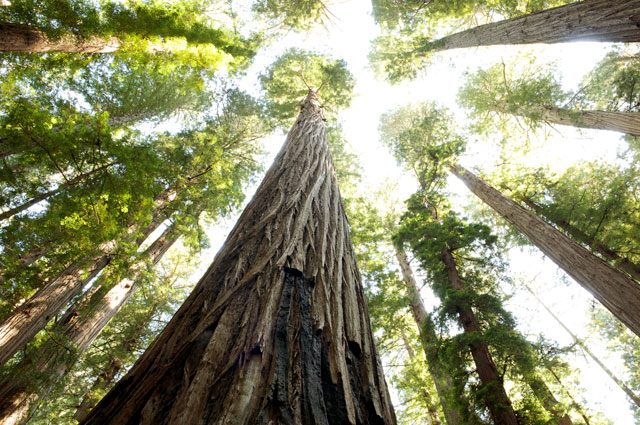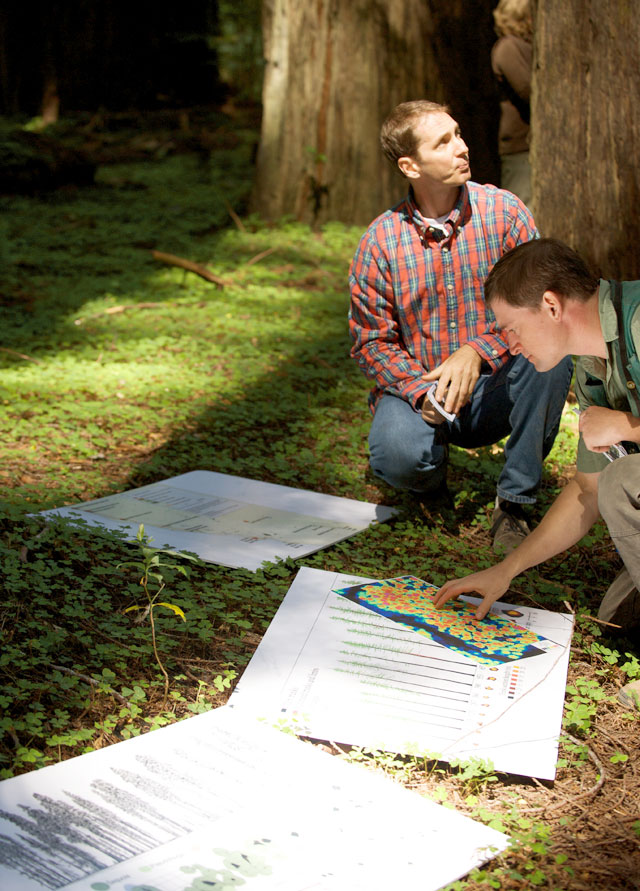
Using new scientific approaches, cutting edge technology, and arboreal savvy, the team is gathering the most detailed information ever on the structure and function of redwood forest ecosystems. The multi-pronged effort will provide real-time knowledge of the entire 450-mile geographic distribution of coast redwoods as well as giant sequoias, which are restricted to 75 groves in California’s Sierra Nevada. It’s all with an eye to improving conservation and management of redwoods via the deeper understanding provided by long-term monitoring of intact forests, dendrochronology (the study of tree rings), and laboratory experiments.
The “Redwoods and Climate Change Initiative” is spearheaded by the Save the Redwoods League.
“This is the most integrated and extensive redwood research project in history,” says HSU forestry professor Steve Sillett.
“These data will help shape future conservation and restoration policies by providing accurate tree- and forest-level metrics of photosynthesis, water use, wood production, carbon storage, and ecosystem services,” he says. “This research will help us anticipate the nature and intensity of threats posed by rapid climatic changes, including alterations in temperature, rainfall, fog, and frequency and intensity of fire.”
The project will also lead, Sillett says, to a better understanding of how effectively redwood forests store carbon in biomass. Because these are the tallest and most massive forests—and both redwood species have extreme resistance to fire and wood decay—their capacity for carbon sequestration likely exceeds all other forests on Earth.
Sillett holds the Kenneth L. Fisher Chair in Redwood Forest Ecology and directs the HSU Institute for Redwood Ecology. Also on the team from HSU are Dr. Robert Van Pelt, one of the world’s leading experts on trees and forests; Allyson Carroll, a top-notch dendrochronologist; Marie Antoine, a researcher and lecturer at HSU, as well as Jim Spickler and Giacomo Renzullo, scientists with Eco-Ascension Research and Consulting who are both graduates of HSU. Graduate and undergraduate students are also involved.

The two scientists from UC Berkeley are Todd Dawson, director of the Center for Stable Isotope Biogeochemistry, and Anthony Ambrose, who completed his Ph.D. on coast redwood and giant sequoia physiology at Berkeley in 2009. Prior to Berkeley, Ambrose was a Master’s student of Sillett’s at HSU.
To carry out the study, the scientists are focusing on sixteen 1-hectare plots within old-growth forests throughout California. In each plot, the team will measure all vegetation and every tree from top to bottom, create detailed structural maps, and accurately quantify biomass, volume, surface area, and water-holding capacity of the vegetation. Tree size, age, and growth will be measured directly, and the team will integrate these data with results from stable isotope analyses of tree rings, climate records, remote sensing, and computer modeling. Microclimates will be monitored by hundreds of small, solar-powered devices placed throughout the forest canopy.
Ultimately, these scientific results will reveal not only how redwood forests responded to past climates but also how redwoods will likely respond to future changes, especially those anticipated as a consequence of global warming.
“We’re measuring everything that’s measurable,” says Ruskin Hartley, the executive director of Save the Redwoods League.
The first three years of the project are crucial. The league has committed to raising funds for the estimated $2.5 million cost of this phase and has already sent an initial $300,000 to HSU.
The League and Humboldt State will be seeking further funds for the project. In addition, HSU alumnus Ken Fisher (’72), who established the HSU chair in Redwood Forest Ecology in 2006, is participating.
See more on the web
Northern California print and broadcast media have given extensive coverage to the project – including the KABC-TV in Los Angeles, the San Jose Mercury-News and Santa Rosa Press Democrat, and locally in the Eureka Times-Standard and North Coast Journal.
For more about the Redwood Climate Change Initiative, visit http://www.savetheredwoods.org/protecting/climate_change.shtml
For more about HSU’s Institute for Redwood Ecology, visit http://www.humboldt.edu/redwoods.